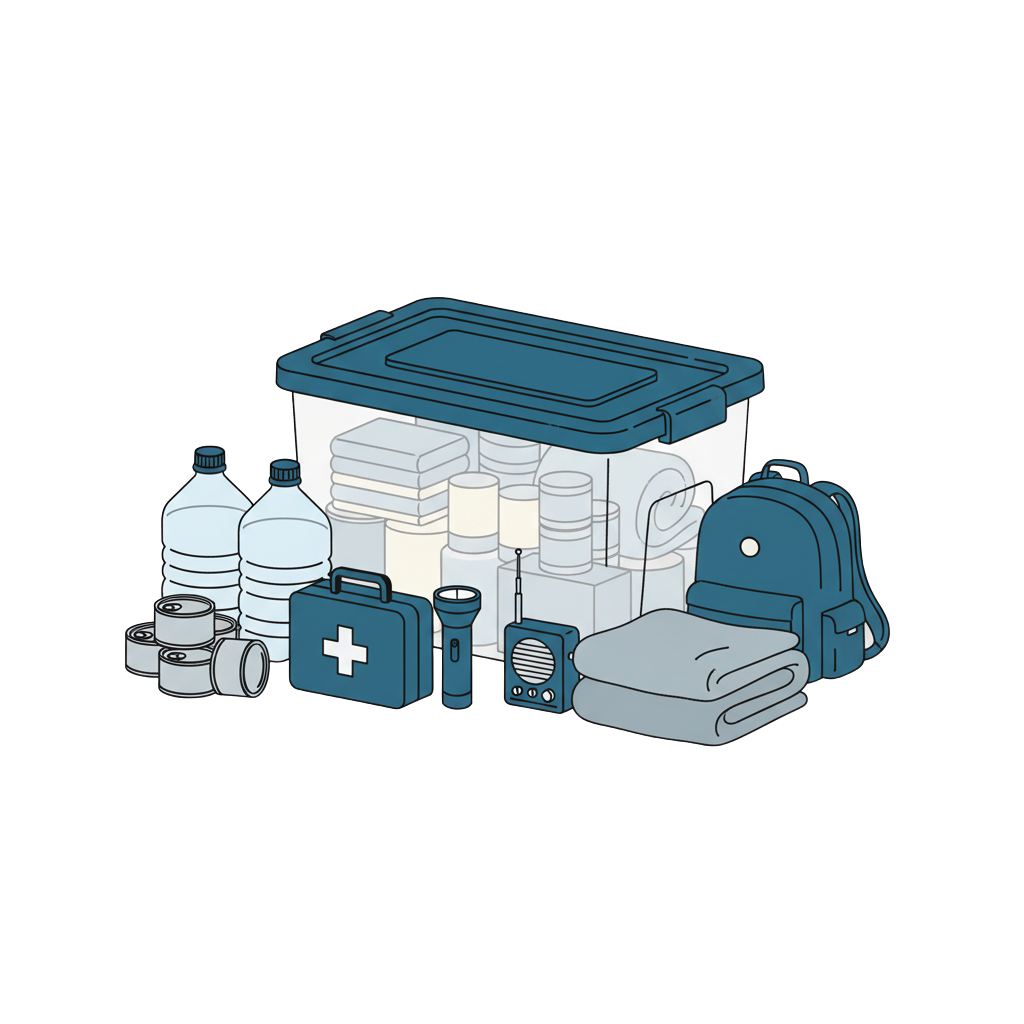Thinking about building an emergency kit can feel like a monumental task. Often, the lists seem endless and it’s easy to feel overwhelmed. This can lead to “preparedness paralysis”—the feeling of being so stuck that you do nothing at all.
Fortunately, assembling a comprehensive home emergency kit doesn’t have to be complicated. This guide is designed to transform that feeling of being overwhelmed into a manageable weekend project. In the following sections, we’ll break down exactly what you need for a 7-day home kit, why you need it, and how to organize it.
First, however, it’s important to understand the difference between two key items:
- A Home Emergency Kit: A large collection of supplies for sheltering in place for an extended period.
- A Grab-and-Go Bag: A portable, lightweight version of your kit, ready for a quick evacuation.
This article focuses on building your primary Home Emergency Kit.

Why a 7-Day Kit is The Standard in BC
After a major disaster, such as an earthquake or flood, essential services can be disrupted for a long time. For instance, power, water, and communications could be out for days, if not weeks. During this time, emergency services will be focused on the most critical situations.
Therefore, official sources like PreparedBC and the Canadian Red Cross recommend having enough supplies to be self-sufficient for a minimum of seven days. Ultimately, this ensures your family can remain safe and comfortable while response efforts are underway.
Your Home Emergency Kit Checklist: The Core Four
Building your own DIY emergency kit is simpler when you break it down into four core categories. Focus on gathering these essentials first.
1. Water
Without a doubt, this is the single most important item in your kit. You should store your water in a cool, dark place. If possible, use commercially bottled water, as it is sterile.
- Quantity: Plan for at least four litres of water per person, per day. Two litres are for drinking, while the other two are for cooking and sanitation. For a family of four, this means you’ll need 16 litres per day, or 112 litres for a full week. Also, don’t forget to include extra for any pets.
2. Food
Your kit should have a week’s supply of non-perishable food that requires little or no cooking. Focus on foods your family will actually eat.
- Types of Food: Canned goods (stews, fish, vegetables), dried fruit, nuts, granola bars, and peanut butter are excellent choices.
- Essential Tool: Remember to pack a manual can opener.
3. Light & Communication
In a power outage, you’ll need to see in the dark and stay informed.
- Lighting: Every family member should have a flashlight. Crank-powered flashlights are ideal as they don’t require batteries.
- Communication: A battery-powered or crank-powered radio is essential for listening to official updates from authorities.
4. First-Aid & Sanitation
Being able to treat minor injuries and maintain hygiene is crucial for your family’s health and comfort.
- First-Aid: You can buy a pre-made kit or build your own. It should include bandages, antiseptic wipes, pain relievers, and any personal medications. The Canadian Red Cross has an excellent guide on what to include.
- Medications: Have at least a 7-day supply of all necessary prescription medications.
- Sanitation: Include toilet paper, garbage bags, and disinfectant.
Beyond the Basics: Customizing Your Kit
A truly effective kit is personalized for your family’s specific needs.
- For Households with Infants: Pack extra formula, diapers, bottles, and baby food.
- For Households with Pets: Include a week’s supply of pet food and water, plus any necessary medications.
- For Specific Medical Needs: Ensure you have backup supplies for any medical equipment that relies on power, and a list of prescriptions and dosages.
Frequently Asked Questions (FAQ)
Here are direct answers to some of the most common questions about emergency kits.
What should I put in an emergency grab-and-go bag?
A grab-and-go bag is a portable 72-hour version of your home kit. It should include water, non-perishable food, a first-aid kit, medications, a flashlight, a radio, copies of important documents, and personal hygiene items4.
Is it cheaper to build your own emergency kit?
Yes, it is often cheaper to build your own kit. It allows you to buy items on sale over time and include foods and brands your family prefers, which reduces waste.
How do I build my own emergency kit?
Start by gathering the “Core Four”: a 7-day supply of water and non-perishable food, lighting and communication devices, and first-aid and sanitation supplies. Then, add items specific to your family’s needs, like pet supplies or infant formula.
How do I make a grab-and-go bag?
Use a sturdy, comfortable backpack. Pack it with enough essential supplies to last for 72 hours, focusing on lightweight and portable versions of the items in your main home kit.
Important Links & Official Resources
For more detailed official guidance, we recommend these excellent resources:
- PreparedBC: Build an Emergency Kit and Grab-and-Go Bag
- Canadian Red Cross: Get an Emergency Kit
Your Plan is The Next Step
Building this kit is one of the most empowering actions you can take for your family’s safety. But a kit is only one part of the puzzle. The next step is a comprehensive, written plan that outlines how you’ll communicate, where you’ll meet, and what to do in specific emergencies.
If you’re ready to take that next step, OurSafetyPlan.ca guides you through the entire process, creating a personalized plan that gives you true peace of mind.
